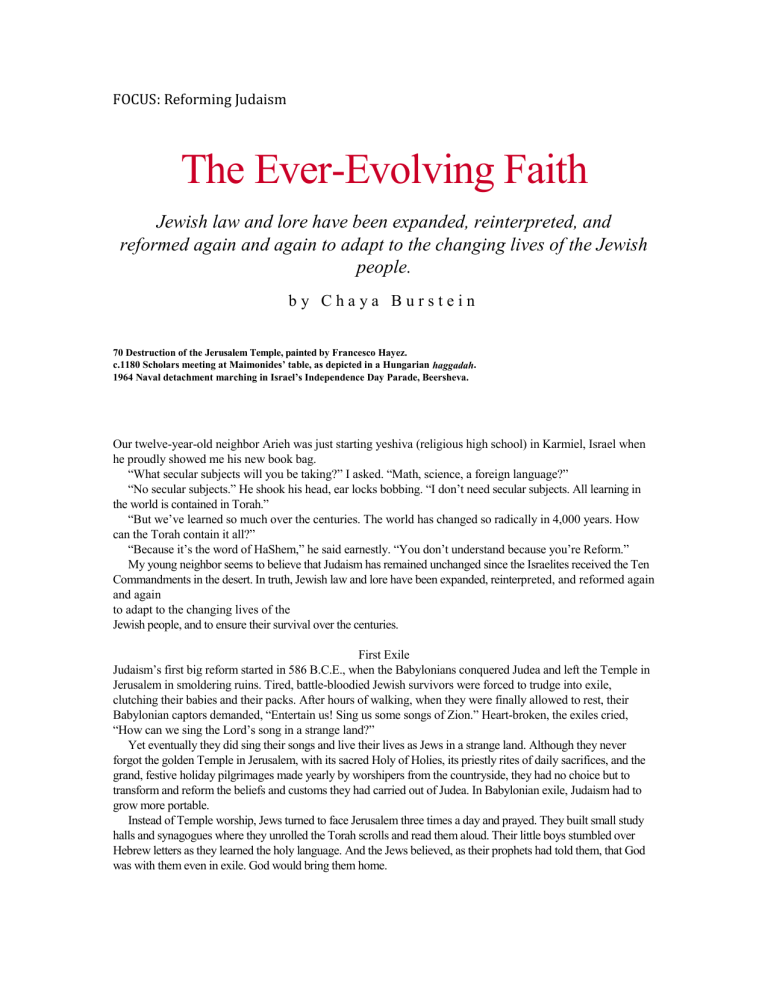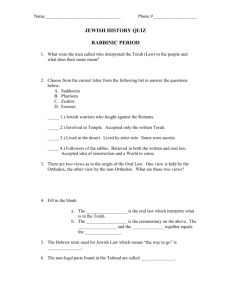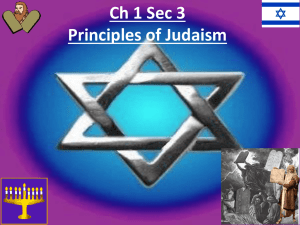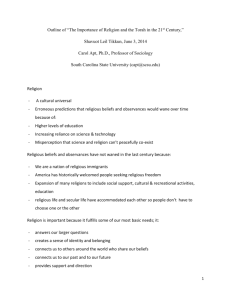FOCUS_Evolving - reformjudaismmag.net

FOCUS: Reforming Judaism
The Ever-Evolving Faith
Jewish law and lore have been expanded, reinterpreted, and reformed again and again to adapt to the changing lives of the Jewish people.
b y C h a y a B u r s t e i n
70 Destruction of the Jerusalem Temple, painted by Francesco Hayez. c.1180 Scholars meeting at Maimonides’ table, as depicted in a Hungarian haggadah.
1964 Naval detachment marching in Israel’s Independence Day Parade, Beersheva.
Our twelve-year-old neighbor Arieh was just starting yeshiva (religious high school) in Karmiel, Israel when he proudly showed me his new book bag.
“What secular subjects will you be taking?” I asked. “Math, science, a foreign language?”
“No secular subjects.” He shook his head, ear locks bobbing. “I don’t need secular subjects. All learning in the world is contained in Torah.”
“But we’ve learned so much over the centuries. The world has changed so radically in 4,000 years. How can the Torah contain it all?”
“Because it’s the word of HaShem,” he said earnestly. “You don’t understand because you’re Reform.”
My young neighbor seems to believe that Judaism has remained unchanged since the Israelites received the Ten
Commandments in the desert. In truth, Jewish law and lore have been expanded, reinterpreted, and reformed again and again to adapt to the changing lives of the
Jewish people, and to ensure their survival over the centuries.
First Exile
Judaism’s first big reform started in 586 B.C.E., when the Babylonians conquered Judea and left the Temple in
Jerusalem in smoldering ruins. Tired, battle-bloodied Jewish survivors were forced to trudge into exile, clutching their babies and their packs. After hours of walking, when they were finally allowed to rest, their
Babylonian captors demanded, “Entertain us! Sing us some songs of Zion.” Heart-broken, the exiles cried,
“How can we sing the Lord’s song in a strange land?”
Yet eventually they did sing their songs and live their lives as Jews in a strange land. Although they never forgot the golden Temple in Jerusalem, with its sacred Holy of Holies, its priestly rites of daily sacrifices, and the grand, festive holiday pilgrimages made yearly by worshipers from the countryside, they had no choice but to transform and reform the beliefs and customs they had carried out of Judea. In Babylonian exile, Judaism had to grow more portable.
Instead of Temple worship, Jews turned to face Jerusalem three times a day and prayed. They built small study halls and synagogues where they unrolled the Torah scrolls and read them aloud. Their little boys stumbled over
Hebrew letters as they learned the holy language. And the Jews believed, as their prophets had told them, that God was with them even in exile. God would bring them home.
Rabbinic Judaism
Forty-eight years after the exile began, Cyrus, king of the Persians, conquered Babylonia and permitted the Jews to return to their land. What turned out to be a brief experience of exile became a valuable dress rehearsal for the catastrophe that followed in 70 C.E., when the Romans crushed a Jewish rebellion, destroyed Jerusalem and the Second Temple, and expelled huge numbers of Jews from Palestine.
The exiles spread into the Mediterranean world, establishing small and isolated Jewish communities in a sea of “foreign peoples.” Facing persecution and pressures to convert, they clung to the Torah as their tree of life, but it needed new branches and foliage to adjust to the changing climates of the diaspora. Teachers and scholars in Babylonia and northern Palestine worked across seven centuries to develop the Talmud, which explained the Torah’s tersely written laws and expanded its concepts to accommodate the changing Jewish reality.
Where the Torah had only hinted at an afterlife, for example, the Talmud developed clear concepts of heaven and hell to comfort and guide the Jews in their difficult lives as exiles and minorities—promising that this life is only an anteroom leading to the heavenly life to come.
Over the centuries of its compilation, the Talmud refined Jewish ethical and social thinking. The punitive
“eye for an eye and tooth for a tooth” acquired from Babylonian law was gentled to require compensation instead. For example: one punch equaled one shekel; one back-handed slap or pulling an ear required 400 zuzim; serious injuries necessitated punitive compensation.
Holidays such as Sukkot, Pesach, and Shavuot, which had formerly been biblical harvest festivals, were reexamined to take on new religious and historic meaning for the uprooted nation. Shavuot, for one, which celebrated both the spring wheat harvest and the first fruit harvest in ancient Palestine, was considered a minor holiday until the rabbis of the Talmud deemed it the holiday celebrating the giving of the Torah on Mount Sinai.
It evolved further in the Middle Ages, when young children started Torah study on the holiday. Another evolution: In the last two centuries, it has become the day Reform teens have celebrated their confirmation.
Challenge to Rabbinic Judaism
A challenge to the Talmud’s authority rose when the Babylonian Jewish leader Anan ben David rejected the extra-biblical laws and opinions that rabbinic Judaism had developed. Insisting that only the original Torah was
God’s word, he accused the rabbis teaching Talmud of being imposters and hypocrites. Ben David believed that
Judaism’s purpose was to prepare for the final redemption. So long as Jews remained in exile, they needed to mourn the loss of their land and Temple. Storming into holiday parties wearing his dark cloak of mourning, he scolded the celebrants, “How can you laugh and drink wine? Our Temple is destroyed. Our land lies desolate.
Blow out the candles! Douse the oil lamps! We must sit in the dark on Shabbat as the Torah commands. We must pray for God’s forgiveness and obey every letter of every law in the Torah. Only then will we bring the redemption.”
A large group of followers called Karaites gathered around Ben David. Some found the Torah easier to follow than the commentaries and interpretations of the contentious rabbis of the Talmud.
Again Jews faced a choice. Should they try to live within the limits imposed by the Torah? Should they sit in the dark on Shabbat or enjoy the holiday by the light of a previously lit Shabbat lamp, as the rabbis suggested?
Should they dedicate their lives, studies, and prayers to bringing redemption or should they enjoy God’s gifts of life, family, community, and prayer?
The continued practice of Karaism with its focus on a destroyed Temple and hopes for redemption might have led the Jews into a dead end. Rabbinic Judaism, in contrast, gave Jews guidance in adapting to new environments as well as philosophical tools to compete with Christianity and Islam. A majority of Jews chose to go forward. Karaism was eventually reduced to small sects of purists.
The following story, told by a 10th-century rabbi in the manuscript Seder Eliahu Zutta , describes the rabbis’ purpose in expanding and reforming some of the original Torah text:
What is the difference between the written law (Torah) and the oral law (Talmud)? To what can the two be compared? To a king who had two servants and loved them both. He gave each of them a measure of wheat and a bundle of flax. The wise servant took the flax and spun a cloth. He took the wheat and made flour. He ground, kneaded, and baked the flour. Then he set it on the table, covered it with cloth, and waited for the king to return.
The foolish servant did nothing at all.
After some days, the king returned and said to the servants, “Bring me what I gave you.”
One servant presented bread covered by cloth, pleasing the king. The other, now disgraced, displayed the wheat still in the box covered with a bundle of flax.
When the Holy One gave the Torah to Israel, He gave it only as wheat, for us to extract the flour, and flax, for us to spin a garment.
Torah text, the original wheat and flax, met the needs of farmers, shepherds, and village people living in close communities. The later explanations and interpretations of Torah (the wheat bread and woven cloth) met the changing needs of isolated, wandering, and often urban Jews. An example: When the biblical prophet Jeremiah was carried off into exile, he called on his people to “Seek the peace of the city whither I have caused you to be carried….” In the Talmud, seven centuries later, Rabbi Samuel widened the dicta and ruled, “The law of the government [of the land in which you live] is binding law,” thus ensuring pragmatic acceptance of a problematic situation.
From Maimonides to Mysticism
Through the next eight turbulent centuries, Jewish communities in Europe and North Africa faced persecution and repeated expulsions. Heart-rending problems arose that local rabbis felt incapable of resolving. They sought answers from “experts,” the renowned rabbis of Babylonia and other large centers. These answers—responsa— became part of the growing body of Jewish law. In the 12th century, Rabbi Mosheh Ben Maimon (Maimonides), the great rabbi, physician, and philosopher, was asked what an observant Jew should do if threatened with death should he or she refuse to convert. His pragmatic “Letter Concerning Apostacy,” which stated that the Jew might simulate conversion and wait patiently until the oppressor’s fanaticism eased and he/she could return to
Jewish practice, helped ensure the Jews’ survival.
Beaten down by the Crusades, blood libels, and other travails, Jews of the 13th and 14th centuries were ready to be empowered by a new mystic movement called Kabbalah. The Zohar (splendor), a mystical commentary on
Torah written by Moses de Leon of Spain, stressed the power of prayer, atonement, and other techniques
(astrology, numerology, angels, demons, etc.) to break Satan’s grip on humankind, after which the Messiah would be free to arrive, bringing God’s redemption. Suddenly each brow-beaten Jew could become a fighter in the battle to bring God’s kingdom, through study and meticulous observance of Torah as well as continuous selfexamination and purification. The Kabbalah movement enriched Judaism by giving people hope, joy, purpose, and strength in their struggle to reach God, but it also made use of amulets, exorcisms, talismans, and other superstitions. Among its far-reaching effects: a strong messianic movement and the later development of
Chasidism.
False Messiah
In the 17th century a wave of murderous pogroms tore through the world’s most populous Jewish communities in Eastern Europe. Russian Cossacks fighting for freedom from their Polish overlords wiped out some 300,000 Jews along their way. In subsequent invasions by Russia and Sweden, Poland was dismembered.
Pogroms would rage for another hundred years. Amidst this chaos arose a charismatic, would-be messiah,
Sabbatai Zvi, who inspired Jews across Europe, Asia, and Africa to sell their belongings in anticipation of returning to the Holy Land. In 1666, the Sultan of the Ottoman Empire forced Zvi to convert to Islam, unleashing a wave of Jewish despair. In Europe people huddled into knots of fierce orthodoxy. Much of the learning became drill, dry memorization of holy books. Scholars engaged in obtuse arguments about words that had little to do with people’s everyday lives. The joy was gone—until Rabbi Israel Eliezer, later known as the Baal Shem Tov
(master of a good name), brought it back.
Chasidism
As a young man, Israel Eliezer earned a meager living by bringing little boys to religious school. After he married, he and his wife moved to a village in the Carpathian Mountains, where he dug lime that his wife sold in nearby towns. In the mountains, Israel studied Kabbalah, prayed, and came to believe that God was everywhere: in every rock, leaf, squirrel, and person. And since God was good, actual or potential good existed in all things. The world was full of beauty, melody, and joy. And one’s prayers were not as important as one’s love of and devotion to God. In the mid-1730s, Eliezer brought his beliefs to the shtetls of Eastern Europe, attracting a large following. His disciples, called Chasidim (pious ones), turned away from intense Torah study and instead worshiped God with exultant singing and dancing.
The Baal Shem Tov taught that Jewish religion was not controlled by a learned elite, but belonged to every
Jew; the prayers of an ignorant goat herder and a learned rabbi were equal in God’s eyes. Such teachings infuriated traditional rabbis who believed the Baal Shem Tov was undermining respect for Torah learning as well as their own elevated status. The battle which ensued tore families apart.
Chasidism continued to spread after the Baal Shem Tov’s death, prompting the scholarly Gaon of Vilna to convene a rabbinic court and declare the excommunication of the Chasidic leader. Candles were lit in the synagogue and solemnly extinguished, the shofar was blown, and a prayer of anathema denouncing the Baal
Shem was read aloud. Nevertheless, Chasidism expanded through much of Central and Eastern Europe.
Despite the dissension Chasidism caused and the increase in superstitious practices that accompanied its teachings, the movement had a powerful reforming influence on Jewish life. It turned Judaism away from a grim, sterile religious academicism practiced by an elite to a joyous, democratic expression of love of God and people.
Emancipation
The Eastern European Jewish world remained tightly shut against western influences into the 1800s, but Western
Europe was seething with new ideas. Manufacturing and commerce were growing. Kings fell as revolution broke out in France and spread to neighboring lands. The Jews of those lands were suddenly free to move out of ghettos. It was an exhilarating change for many, but some of the newly emancipated Jews became embarrassed and uneasy about their traditional ideas and practices. Conduct that had seemed appropriate in the ghetto appeared chauvinistic and even crude in the outside world. In Seesen, Germany, a movement for reform of
Jewish worship began. In 1810 the reformers opened their first synagogue. It would revolutionize Jewish life for more than two centuries to come. (To learn more about the origins of Reform Judaism, see “In Search of
Belonging” on page 48.)
Zionism & Israel
Seventy years after the first Reform temple in Germany opened its doors, many Jews in Eastern Europe began to migrate to the West in search of greater freedom; a few others, inspired by Jewish history and tradition, sought to establish their own national home in the land of Israel. Jews around the world contributed money to help build the land. The Holocaust, destroying one third of world Jewry during World War II, was a factor in bringing the question of Jewish statehood to the podium of the United Nations, which voted to establish both
Jewish and Arab states in British-occupied Palestine.
On a tense evening in May 1948, the leaders of the Jewish Agency for Palestine declared the establishment of the State of Israel. Immediately the Egyptian air force bombed Tel Aviv and the armies of five Arab states attacked the new state. The Jews fought back and prevailed.
Opposition to the Jewish state also came from within. Leaders of ultra-Orthodox factions rejected Jewish statehood on the grounds that only the Messiah, sent by God, could bring the Jewish people back to the
Promised Land; they deemed the secular Jewish state a violation of Torah.
Most Jews ignored the ultra-Orthodox view. For them, Zionism had reformed the traditional view that God alone could bring the Jewish people home. The horrors of the Holocaust, the attacks on Jews in Arab lands, and the euphoria of having their own homeland stirred Jews throughout the world to flood into Israel. They lived in tents, struggled with learning Hebrew, and toiled at menial labor, but felt empowered and unafraid, living in their own land at last.
Today, world Jewry continues to reform and rethink its relationship with Israel. We recite, “Next year in
Jerusalem” at the end of our seders. We pray for dew in the spring and rain in the fall, even though the lands we live in may be flooded with rain or smothered in snow. Golden Jerusalem is still central to Judaism and Diaspora
Jews care deeply about Israel’s welfare, even though few Jews throughout the world pack up and make aliyah.
Many, though, give serious thought as to what the state should or should not do about the Arabs, refugees, a twostate solution, religious pluralism, women’s rights, and more. Can we expect a modern state with horrendous problems of military security and serious shortages of water, land, and other natural resources to live up to the moral standards set by the Hebrew prophets? And should a Zionist state relinquish part of the land promised to the Jewish people in the Bible for the hope of peace?
Rethinking and reforming of Jewish beliefs are likely to continue.
Thankfully, we possess a powerful core of Torah and a tough, resilient body of tradition to help us interpret, reevaluate, and reform our beliefs. And, I expect, my young neighbor Arieh will become one of
thousands of Jews who will serve as future repositories of the source material—Torah—from which we will continue to draw our wisdom.
Chaya Burstein is author of numerous books, including Our Land of Israel and The Mystery of the Coins (URJ Books and
Music), and most recently The Amazing History of the Jews (in cartoon form), due out in Fall 2011.
© Maksim Masalski / Dreamstime.com; Cameraphoto Arte, Venice / Art Resource, NY; Private Collection / Archives
Charmet / The Bridgeman Art Library International; Photo by Moshe Pridan / The State of Israel National Photo
Collection









